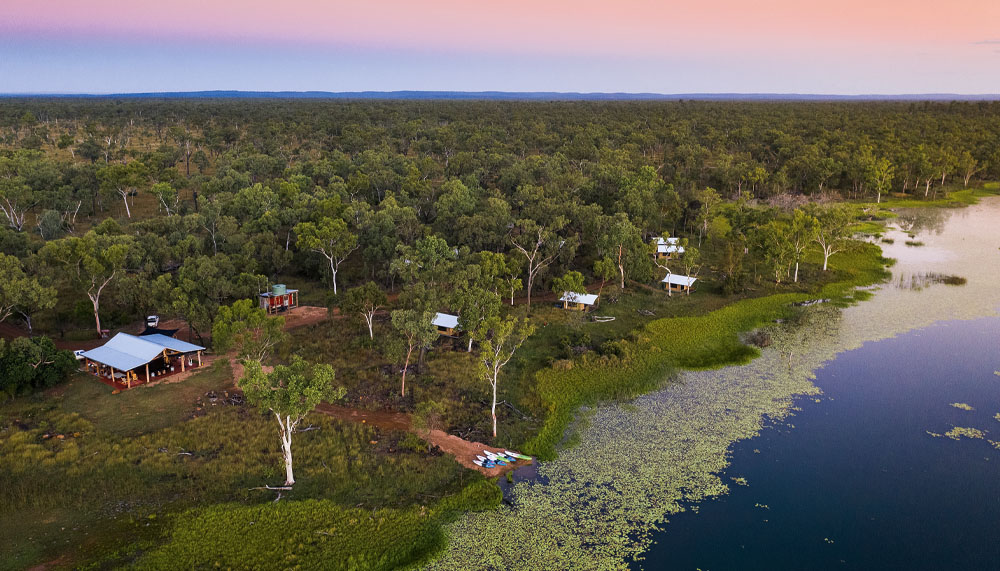With a rare mix of tropical rainforest, volcanic country, open savanna, native grasslands and station life, Kinrara is open to visitors.
Story Paula Heelan Photo Alex Heil
Expressive, witty and bracingly open, Callum O’Brien is talking zealously about Kinrara. Today he’s heading out of Cairns in a 4WD pulling a converted trailer packed with luggage, fresh supplies and four passengers for a four-night stay. In 2016 Cal ditched a successful corporate career to return to his bush roots.
In partnership with his eldest brother Shane and sister-in-law Robyn, who now own and operate the Kinrara cattle enterprise, ecotourism and carbon sequestration operation, the family created Kinrara Expeditions. “For years I’d wanted do something to share this amazing place with others,” Cal says. “I suddenly realised I had the qualifications needed to make it work, the time was right and Shane and Robyn were keen to help make it happen.”
Anticipation for the next five days heightens as Cal explains more of Kinrara’s unique and multifaceted environment. In 1969, his grandfather Stephen O’Brien drew Kinrara’s neighbouring property, Craig’s Pocket, in a land ballot. In 2002 the family bought Kinrara.
“The landscape has been shaped and frozen in time by Australia’s youngest volcanic eruption, which happened about 7000 years ago,” Cal says. “It left behind an intact volcano with a crater and 30km of solidified lava flow that can be seen from space, and a landscape that sustains rainforest, wetlands, permanent spring-fed creeks, open woodlands and grasslands, and is the source and beginning of the Burdekin River.” The cattle station operates over 20,235ha and, depending on the season, the family has more than 5000 head of cattle. The national park it surrounds covers another 8094ha, of which the O’Briens are stewards.
After travelling through the everchanging countryside from Cairns, a hearty lunch at the restored 1920s Ravenshoe Pub and a scenic 300km drive south-west of Cairns, the 4WD pulls into the Kinrara camp site. Nestled alongside Kinrara Lake is an open pavilion, which is the central gathering place, and spacious safari tents are nearby. It’s late afternoon and Kinrara is drenched in soft, golden light. The lake is bustling with birds. Of the 220 species recorded here, tonight’s stand-outs are magpie geese, sea eagles (flown in from the coast to nest), ducks, parrots, kookaburras and galahs. A few black Angus cattle and a small mob of pretty-faced wallabies feed quietly on the water’s edge.
The Kinrara Expedition team members are quick to welcome new guests and whisk away luggage to individual double tents, which are complete with plush beds, wooden floors and private decks. Everything has been designed and placed with clever attention to detail – the original cement sinks and brass taps in the rustic eco-washroom, the cypress pine and corrugated iron pavilion built like an authentic outstation, hammocks, Adirondack chairs, the down-to-earth enamel mugs, bowls and plates, the bookshelf with a mix of fiction and local reference books. It’s simple, eco-friendly luxury. With not more than 12 guests at a time and staff members mindful of your every need, there’s a sense of splendid solitude and connection to nature.
A fire pit is blazing in front of the pavilion and welcome drinks are clinking. Totally off-grid now, against a stunning backdrop and with no mobile devices or wi-fi, lively conversation flows easily and a sense of exhilaration sets in. Cal calls it ‘first night fever’. “When it sinks in just how removed you are from life’s hustle and bustle, you start to feel relaxed, and over the next few days you slow down. It’s a time to refocus on the things that matter by connecting to the country and yourself. I believe those who come are the ones who need to be here.”
This story excerpt is from Issue #141
Outback Magazine: February/March 2022









